Look Kéo Blade Carbon Ceramic pedals review
Look has put ceramic bearings in its flagship Kéo Blade pedals

The Look Kéo Blade Carbon Ceramic represents the acme of Look’s pedal tech. You’d be hard-pressed to notice the effect of the swap to ceramic bearings, but the changes in bearing material and placement should lead to increased stability and longevity. The Kéo Blade Carbon design is prone to creak, unlike a pedal with an enclosed spring.
-
+
Lightweight
-
+
Streamlined design
-
+
Positive engagement
-
+
Low friction bearings
-
-
Only two fixed release tension options, unless you buy another blade spring
-
-
Tendency to creak once wet and dirty
- -
You can trust Cycling Weekly.

Look has a new top of the line pedal. Apart from the Ceramic legend on the spindle, the Look Kéo Blade Carbon Ceramic pedal is superficially the same as the steel bearing options.
But inside, there are new ceramic bearings, that Look says not only reduce friction by 18% but also increase power transfer. Look says that the bearings also last between four and six times longer.
The Look Kéo Blade pedal uses a leaf spring under the pedal body to close the cleat, rather than the more conventional coil spring found in the Kéo 2 Max pedal and all of Shimano’s pedals.
Look says that this is around 40% lighter than a conventional spring – at 232g a pair, the pedal weight for the Look Kéo Blade Carbon Ceramic certainly undercuts all Shimano’s pedals except the new Dura-Ace. The (non-ceramic bearing) Blade Carbon Ti drops the weight even further by using a titanium spindle.

The Look Kéo Blade design, used in the Kéo Blade Carbon Ceramic, the Kéo Blade Carbon and the Kéo Blade Carbon Ti, comes with a 700 square millimetre engagement platform that is 67mm wide. The Ceramic and the Titanium options get a more structured stainless steel top plate with raised sections at its sides for increased stability.
There’s also an entry level Kéo Blade with a composite body, which continues the previous design.
>>> Shimano Ultegra pedal review
Although it’s hidden from view, the pedal spindle on the Kéo Blade Carbon Ceramic has been redesigned too. It comes with a new end-cap and improved double seal to the inboard side, to increase resistance to water ingress. I found that it took a few rides before the pedal body hung freely on its spindle, as the seals wore in. but Look says that the seals are IPX7 resistant to being dunked in water and IPX6 waterproof to a pressure washer.
The pedal also has an increased distance between the inboard roller bearing and the outboard needle bearing of 25%, which should add rigidity and improve power transmission. Stack height is just 14.8mm for the pedal and cleat.

Another advantage of the carbon leaf spring is that it makes for a streamlined profile to the underside of the pedal. Look’s pedals are narrower than Shimano’s. They’re a popular choice among pro cyclists, with users including Romain Bardet, the poster boy for the new Ceramic option.
>>> Buy now: Look Kéo Blade pedals (non-ceramic) for £155 from Tredz
Other advantages of the blade spring are a firmer foot hold once engaged and faster action when you unclip. You don’t get the adjustability of a coil spring though. The Look Kéo Blade Carbon Ceramic comes with a 12Nm blade fitted, a spare 16Nm blade and the specialist tools required to change them. You can buy a 20Nm version too, while the cheaper entry level Kéo Blade comes with an 8Nm and a 12Nm blade.
In practice, the 12Nm blade has quite a light engagement tension, so it’s easy to clip in. Engagement is very positive too, with an audible click, even if your cleats are a bit dirty. Clipping out seems to need a slightly different technique to other pedals and I found it took my left foot a while to get used to this. Strangely, my right foot was quite happy though.
>>> How to cycle with clipless pedals
In the dry, the Look Kéo Blade Carbon Ceramic is sweet and quiet. But on wet and muddy roads, I found that it could develop a creak when climbing or riding hard. It’s not too annoying and disappeared once I upped my cadence again, but I did start to wonder if my bottom bracket bearing was the worse for wear.
The Look Kéo Blade range uses Look’s standard cleat design. It’s available with different degrees of float. It’s narrower than a Shimano cleat, but does suffer from significant wear if you do much walking on it.

Thank you for reading 20 articles this month* Join now for unlimited access
Enjoy your first month for just £1 / $1 / €1
*Read 5 free articles per month without a subscription

Join now for unlimited access
Try first month for just £1 / $1 / €1
Get The Leadout Newsletter
The latest race content, interviews, features, reviews and expert buying guides, direct to your inbox!
Paul started writing for Cycling Weekly in 2015, covering cycling tech, new bikes and product testing. Since then, he’s reviewed hundreds of bikes and thousands of other pieces of cycling equipment for the magazine and the Cycling Weekly website.
He’s been cycling for a lot longer than that though and his travels by bike have taken him all around Europe and to California. He’s been riding gravel since before gravel bikes existed too, riding a cyclocross bike through the Chilterns and along the South Downs.
-
 'I'll take a top 10, that's alright in the end' - Fred Wright finishes best of British at Paris-Roubaix
'I'll take a top 10, that's alright in the end' - Fred Wright finishes best of British at Paris-RoubaixBahrain-Victorious rider came back from a mechanical on the Arenberg to place ninth
By Adam Becket Published
-
 'This is the furthest ride I've actually ever done' - Matthew Brennan lights up Paris-Roubaix at 19 years old
'This is the furthest ride I've actually ever done' - Matthew Brennan lights up Paris-Roubaix at 19 years oldThe day's youngest rider reflects on 'killer' Monument debut
By Tom Davidson Published
-
 'One of the hardest races I've ever done in my life' - Tadej Pogačar finishes runner-up on Paris-Roubaix debut after crash
'One of the hardest races I've ever done in my life' - Tadej Pogačar finishes runner-up on Paris-Roubaix debut after crashWorld champion reacts to 'extremely hard' battle with Mathieu van der Poel
By Tom Davidson Published